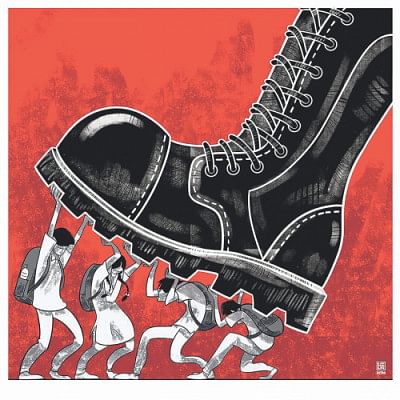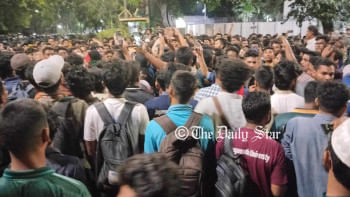Activism in the age of technology and social media

Just when the news of a Dhaka University student getting raped in the capital was taking the country by storm, a group of students of the university came up with a unique way to protest and demand for justice. An event was created on Facebook, titled “A rapist in your path”, and flash mobs were organised at different venues with a feminist anthem in Bengali, a song that bashes patriarchy and rape culture. This chant was inspired by the Chilean feminist chant titled “The rapist is you”. Hundreds and thousands of Chilean women participated in a flash mob singing this song blindfolded, and the video was all over the internet. Similar protest videos where the anthem was sung in different languages kept flooding the internet from all over the world, from Argentina to France, Germany and very recently in Kolkata, India as well.
The chant has been delivering the same message in different tongues from different countries all over the world, and Bangladesh was no exception in this regard when it came to demanding justice.
Shahnaj Parvin Jonaki, one of the organisers of “A rapist in your path” says, “We wanted to do something different, striking and radical at the same time. The video of the Chilean protest was being circulated on social media for many days and it inspired us to the core. We could relate to them and there was a sense of solidarity, as the system is more or less the same everywhere.”
This one example alone can show how protests for a cause can turn universal, breaking cultural and linguistic barriers in the age of social media, where the spark of protests can turn into a wildfire.
The trend in protests and activism has changed a lot in the past decade due to technology, social media and smart phones. It does not take us long to be aware of issues, be it national or beyond the border. Everything is quite literally one click away. Taking a stance for any rightful cause has been easier because of the somewhat uninterrupted flow of information through social media.
Art, music, cartoons, performance arts have always been powerful means of protest and activism. With the rise of social media, such art forms along with pop culture references have been able to make even stronger statements because they reach millions of people at once. From online forums and blogs to even memes now-a-days, everything has been contributing a fair share in activism these days, both cultural and political in nature.

Cartoonist Reesham Shahab Tirtho says, “My satire cartoons that reflect upon recent issues are motivated by the issues themselves. It comes as a response, from an ordinary citizen who has no power to do anything other than expressing his own feelings. It’s true that it reaches more people on social media, but I can’t really tell whether my work is creating any real impact, be that in the real world or in the virtual one. And I really don’t care whether it’s getting viral or not. I do what I do because of the urge to do something, and I will keep doing that, no matter what.”
Social media can reach thousands and millions of people all over the world at once. Even mainstream media often times depend on news and updates circulated via social media. Social media and online forums have the power to mobilise a huge number of people.
If we take a look at the student movements in the past few years in our country, especially the movement demanding justice against the war criminals of 1971 in 2013 and the Road Safety movement in 2018, we can see the trend of organising movements through social media. Be that a Facebook event, or messaging apps like WhatsApp and Messenger, every movement has been organised with the help of technology, internet and social media in some way or the other. Protests which started in one institution, soon made its way to other institutions as well, because internet and social media made it easier for students from different backgrounds to come together with a growing sense of solidarity.
This is not just the case in our country. Millions of people in India are currently protesting against the Citizenship Amendment Act, where in most places the protests are being led by university students. Recently, when many students in JNU, Delhi along with the President of the JNU Student Union were attacked while participating in the on-going movement, social media burst into protest. From Shantiniketan to Jadavpur University in Kolkata to the streets of Mumbai and Delhi, protests broke out in almost every major city of India, and once again, a huge number of people came down on the streets, organising themselves via Facebook, Twitter, Instagram and WhatsApp.
This is not the case in the subcontinent only, from the Arab Spring to Chile and the rest of South America to Climate activists in Europe and other continents, every movement has a somewhat similar story.
Professor Shamsad Mortuza, Department of English, Dhaka University and currently the Pro- Vice Chancellor of University of Liberal Arts Bangladesh (ULAB) says, “Whether we like it or not, social media is the only social space that is left. There is still a semblance of freedom here as long as someone is not too radical or anti-government in orientation. Social media has been able to generate enough energy to dethrone a very powerful minister during the Safe Street movement. Shahbag is a glorious example where social media gave the initial breakthrough. It was later hijacked by political agents - but that’s a different issue. Many humanitarian gestures, social gathering and cultural events have their origins in social media. The virtual space is becoming a serious check-post for lived reality.”
Social media and online forums are not the only things that have redefined the ways of activism in recent times, there are other technological aspects other than the widespread use of internet as well. For example, FireChat, a free messaging app that works without mobile data, Wi-Fi or any sort of internet connection at all by working on a peer-to-peer basis, has been used by many protestors all over the world whenever there were situations regarding the unavailability of internet in the area of protests. This app has helped thousands of protestors stay connected with each other, even without internet.
Not everything about organising a movement via social media can be positive. Propaganda too, spreads faster than anything in the age of social media and technology. A movement that is organised through social media can quite easily lose its momentum and deviate from its primary objective.
Amit Pramanik, a student activist studying at Dhaka University, says, “As an activist, dealing with propaganda after organising any movement via social media gets really tough. I think how the mainstream media covers the story of the movement is crucial when it comes to dealing with propaganda. As for the issue of keeping the momentum of the movement, I think that a movement that is organised through social media is bound to lose its momentum at some point because people tend to vent out their frustration solely on social media, to the extent that they forget that their physical presence is much more important to carry out a protest. But I also think the fact that movements organised via social media can lose their momentum after a while is nothing to be disappointed about. I believe that in anywhere around the world, where there is authoritarian control over the mainstream media, social media is the purest source of information we can have. Movements that are anti-establishment or anti-autocracy in nature, are not something that will give us immediate results, rather they can be considered as a part of a continuous process. Even if one movement loses its momentum, it makes way for another and leaves lessons for the activists on how they can organise themselves better in the future and bring about a real outcome.”

 For all latest news, follow The Daily Star's Google News channel.
For all latest news, follow The Daily Star's Google News channel. 



Comments